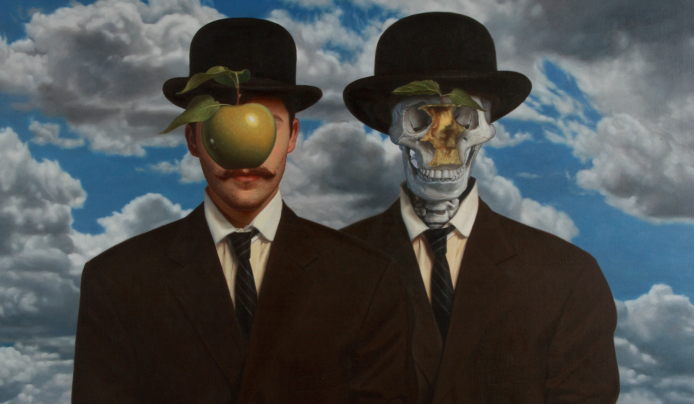Oliver Sacks presents in his famous book “The man who mistook his wife for a hat” a unique case of optical agnosia.
In this case Dr.P., a distinguished musician and teacher, remarkably cultivated and functional in every other way, loses the ability to recognize –optically – items of daily usage, as well as the ability to perceive the people he interacts with as a whole.
He is able to identify simple objects, a cube for instance, but when Sacks hands him a rose Dr.P. takes it and looks at it completely perplexed.
“About six inches in length”, he comments. “A convoluted red form with a linear green attachment.”
“And what do you think it is Dr.P?”, Sacks asks.
“Not easy to say…I think this could be an inflorescence or flower.”
“Smell it” Sacks suggests.
Dr.P. takes it to his nose as if he was asked to smell a screwdriver.
“Beautiful!” he says promptly. ”An early rose! What a heavenly smell!”
~
At some other point he shows him a glove and asks him:
“What do you think it is?”
Dr.P. takes it and examines it: “A continuous surface infolded on itself with five outpouchings”.
“You have given me a description. Now tell me what it is.”
“A container of some sort?”
“What would it contain?”
“It could be a change-purse for coins of five sizes.”
“Do you think it might contain a part of your body?”
Dr.P. scans his own body, his hands, his feet, but he can’t make the connection.
Only when Sacks gets it on him exclaims “My God, it’s a glove!”
When the time has come to leave Sacks’ office, he looks round for his hat.
He approaches his wife who sits closely to him, takes hold of her head and tries to lift it off, assuming that this, her head, is the hat!
~
Another characteristic of Dr.P.’s case was that he was focusing on details missing the whole, seeing the tree and “missing” the wood.
He could recognize a person’s face by its details; his brother by his big teeth, his wife by a mole on her face, Winston Churchill from his cigar.
He couldn’t describe what he saw in a painting or a picture. He could see the stream, the trees, the clouds, but he couldn’t understand exactly what the painting depicted.
~
Aside from a musician, Dr.P. was also a gifted painter.
When Sacks visited him at his home, he found himself before the artistic depiction of the evolution of his neurological disorder. His earlier works were realistic and naturalistic with an emphasis on the details.
A few years later he was painting like Picasso, cubist representations of reality.
Then he was drawing like Kandinsky with obvious geometric shapes and eventually wound up drawing like Pollock: an abstract and chaotic combination of lines and colours.
The evolution of his neurological disorder bears a resemblance with the evolution of painting in the twentieth century.
Eugene Vincent Vidal (1850-1908) Portrait of a Woman with a Fan
Claude Monet (1840 – 1926) Woman with a Parasol – Madame Monet and Her Son
Pablo Picasso (1881 – 1973) – Femme assise (Sitzende Frau), oil on canvas
Vassily Kandinsky (1866-1944) In Blue
Jackson Pollock (1912 – 1956) Number 8
~~{}~~
Upon reading this book, the politicians that govern Greece the last years sprung immediately in Sanejoker’s brain – which could provide enough material for a brief chapter in a neurologist’s book in its own right.
Undoubtedly, they suffer from a rare – and yet widely spread among the politicians of the entire globe – neurological disorder, for which we could coin the term “humanagnosia”.
Politicians act as if they can’t perceive what human beings are.
They focus their attention on abstract definitions like economy, growth index, bank robustness.
~~{}~~
If you show them a man, with flesh and bones, carrying a name and having a family and ask them what they see, they will be confounded.
“It looks like something we tax to meet our obligations to our European partners», they will answer.
“Is this its only utility?” the neurologist will ask.
“We terrify it and mislead it to vote for us”, the politician will reply confidently.
“Do you think that it is a thinking being?” the neurologist will ask.
“I can’t be sure about it” the politician will answer. “It moves, speaks, works, watches TV…But I don’t know if it’s capable of thinking.”
Then the neurologist brings in an unemployed to debate with the politician.
“I am unemployed for two and a half years now, with zilch income and you are asking me to pay preposterous taxes, even though I don’t have enough money to feed my own child”, tells him devastated and one step away from committing suicide.
The politician laughs.
“It looks like a real human being” says to the neurologist. “It’s a delusion, isn’t so?”
He touches the unemployed and examines him from every angle, as if he were an object.
“Is it a robot?” says the politician still laughing. “How does it work, out with it!”
Then the unemployed begins to clobber him in tears.
“You destroyed my life” he shouts, “the future of my children.”
Medical attendants in police uniforms enter the office and put the unemployed into a straitjacket before they drag him outside.
The politician fixes his tie and wipes the blood off his face. Then he laughs again.
“I almost believed that he was real” he says.
He gets up, goes to the closest chair, lifts off the head of the country that once was called Greece and puts it on his head like a hat.
“Watch yourself doc with these experiments, because you’ll get in trouble in the end”, says the politician and leaves to go back to his manor.
The neurologist goes to the window, opens it and climbs to the windowsill.
Tens of people jump from their window trying to fly.
~~~~~~~~~~~~~~~~~~~~~~~~~~~~~~~~~~~~~~~~~~














